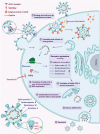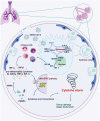Baricitinib combination therapy: a narrative review of repurposed Janus kinase inhibitor against severe SARS-CoV-2 infection
- PMID: 34902115
- PMCID: PMC8666469
- DOI: 10.1007/s15010-021-01730-6
Baricitinib combination therapy: a narrative review of repurposed Janus kinase inhibitor against severe SARS-CoV-2 infection
Abstract
Purpose: The Coronavirus disease 2019 (COVID-19) pandemic is one of the most devastating global problems. Regarding the lack of disease-specific treatments, repurposing drug therapy is currently considered a promising therapeutic approach in pandemic situations. Recently, the combination therapy of Janus kinase (JAK) inhibitor baricitinib has been authorized for emergency COVID-19 hospitalized patients; however, this strategy's safety, drug-drug interactions, and cellular signaling pathways remain a tremendous challenge.
Methods: In this study, we aimed to provide a deep insight into the baricitinib combination therapies in severe COVID-19 patients through reviewing the published literature on PubMed, Scopus, and Google scholar databases. We also focused on cellular and subcellular pathways related to the synergistic effects of baricitinib plus antiviral agents, virus entry, and cytokine storm (CS) induction. The safety and effectiveness of this strategy have also been discussed in moderate to severe forms of COVID-19 infection.
Results: The severity of COVID-19 is commonly associated with a dysregulated immune response and excessive release of pro-inflammatory agents, resulting in CS. It has been shown that baricitinib combined with antiviral agents could modulate the inflammatory response and provide a series of positive therapeutic outcomes in hospitalized adults and pediatric patients (age ≥ two years old).
Conclusion: Baricitinib plus the standard of care treatment might be a potential strategy in hospitalized patients with severe COVID-19.
Keywords: Baricitinib; Cytokine storm; Janus kinase pathway; Repurposing drug therapy; Severe COVID-19.
© 2021. The Author(s), under exclusive licence to Springer-Verlag GmbH Germany.
Conflict of interest statement
The authors declare no competing interests.
Figures



References
-
- Geremia N, et al. A case of vasculitis-like skin eruption associated with COVID-19. Infect Dis Clin Pract. 2020;28:e30–e31. doi: 10.1097/IPC.0000000000000952. - DOI
Publication types
MeSH terms
Substances
LinkOut - more resources
Full Text Sources
Miscellaneous

